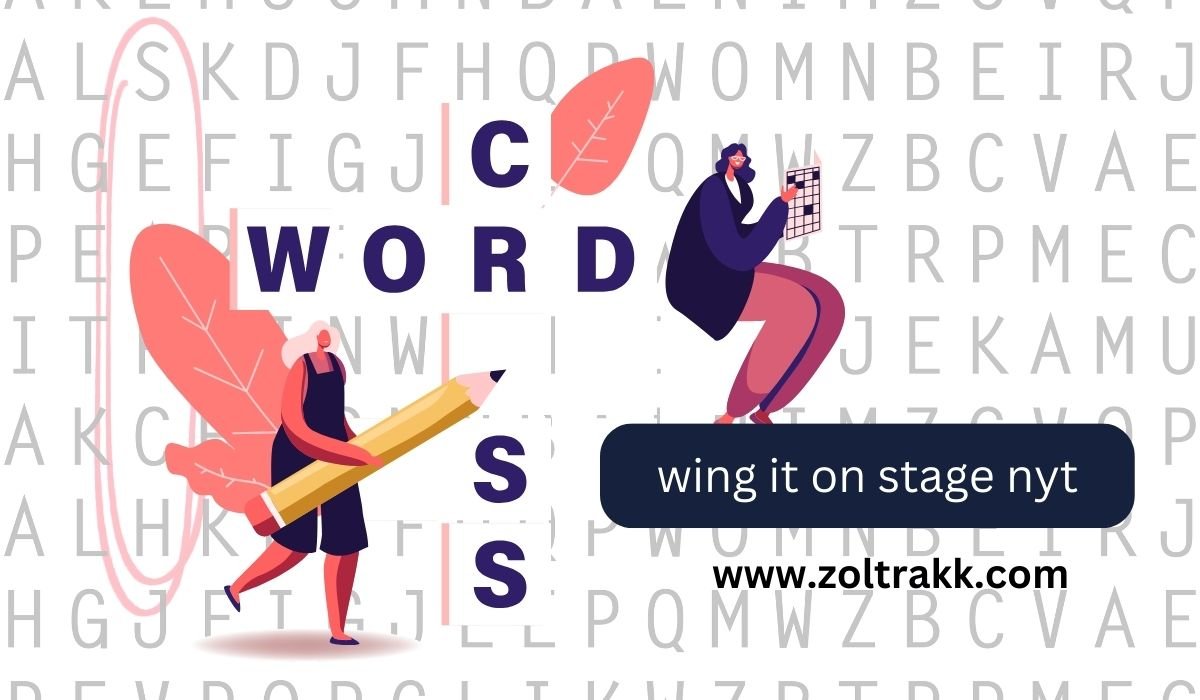Wing it on stage nyt, Wing it on stage” summarizes the thrill and challenge to improvise in any performance-related setting-be it the stage of a theater or stand-up comedy or public speaking. Needless to say, this concept goes beyond live performances and also applies to word puzzles like the New York Times NYT crossword puzzles, where such phrases appear as clues. In this comprehensive guide, we will be talking about what the expression “wing it on stage” means and delve into the importance of improvisation in various forms of performance arts, how to be effective at improvising, and insights from the experts. We’ll also talk about some common questions asked regarding the matter and provide lots of statistics and data surrounding improvisational performance.
What Does “Wing It on Stage” Mean?

Wing it” is a phrase used for performing in which there is no script and no extensive preparation done, but there will be a reliance solely on instincts, creativity, and flexibility. In several cases, such unprepared aspects can culminate in beauty, laughter, or honesty.
Improvisation in performance arts is all about the art that one develops with practice and experience.
Also read: Director cameron nyt crossword clue:
Importance of Improvisation
Improvisation has many different purposes for performance:
- Authenticity: Improvisation lets the performers connect with the audience on an individual level. In view of responding to the energy in the room, it might make such a personal experience resonate with the attendees.
- Creativity: Creativity is encouraged in the light of their creativity; they can think out of the box and stretch the boundaries to reach innovative ideas into manifestations in the performances.
- Adaptability: The power of improvisation allows performance artists to address things they could not know about in advance, such as technical failure or any sudden reaction from the audience, to ensure the show goes on without hitch.
- Audience Participation: Audience Involvement encourages interactive entertainment. When the audience is involved, the performance becomes dynamic, collaborative, and lively.
- Learning Moments: Every spontaneous situation should be an opportunity for them to learn something that will perfect their art or discover techniques that will enhance their art.
Improvisation in Other Performance Arts
Theatre
Improv is widely used when one discovers something in the rehearsals. Actors do an improv exercise while developing characters, on different dynamics, and eventually while improving their performance.
Benefits of Improvisation in Theatre
- Character Development: Improvisation forces the actors to create more details about their characters, thereby making them more comprehensible and multilayered. In improvisation, actors can delve into why their characters act a certain way, and even their quirks and background.
- Improved Chemistry: Improvement in the chemistry of actors can be facilitated by incorporating improvisation to create performances that are natural and real in nature. This is crucial, especially in ensemble works where connectivity comes into the picture.
- Audience Involvement: The unexpectedness of Improv may find fascinating an audience, making the story more interactive, unique moments come only in that performance.
Comedy
Improvisation is the lifeline of most stand-up comedians. Most good comedians construct their acts around what their audience thinks or feels at any given moment derived from real time observations.
Why Comedy Feeds on Improvisation
- Real-Time Interaction: Comedy Comedians can change the content of their performance to accommodate the reaction of the audience, and thus every show is as if it is new and changed for the audience.
- Unscripted Laughter: Some of the funniest laughs come from unscripted interactions or comments occurring during a performance. A simple example might include a comedian riddling on a heckler or an unexpected noise the audience makes.
- Flexibility: Comedians often have to change the material to suit the mood or feel of the crowd. Adaptability, then, is an essential quality for the stand-up comedian.
Public Speaking
Improvisation can really upgrade public speaking, especially in a Q&A session or by having an interaction with the audience.
Advantages of Improvisation in Public Speaking
- Adaptability: Speakers who can respond right away are more likely to pass smoothly through surprising situations.
- Audience Connection: Improvisation creates opportunities for speakers to understand and make sense of their message relative to the audience response. This makes the moment much more interactive and meaningful.
- Authenticity: By being able to improvise, a speaker can respond and adjust to a message in the moment, creating an authentic and relatable rapport that invites the audience to trust.
Coping with Winging It on Stage
Winging it on stage can be intimidating, but those who do well are prepared to handle themselves in these moments.
We adopt the playful mindset. The playful mindset puts more creativity and less anxiety into a person’s mind. It means that performers do not really view each performance as a scary high-stakes event but more as a chance to explore. This would make them feel free to improvise because they are ready to take risks and be open to whatever happens to them.
We practice improvisational techniques
Improvisational theater classes or workshops can be very effective in training someone on the spot. Practices such as “yes, and.” enhance team cooperation and the development of creative ideas to help build the confidence of the performers.
One of the most classic improv exercises has one performer stating a line, then the next person responds by saying “Yes, and…” while adding some extension to the scene. The technique encourages building on other people’s ideas and accepting their offers, which helps with creativity and spontaneity.
Developing a good ear for listening
Listening is an important aspect of any performance, but it is all the more crucial in improvisation because giving back can only happen after being heard. The ability to be attentive toward others-the other performers and members of the audience-will make all the difference in the ability to give an authentic response. It will enable the performer to get cues that may carry him through his responses.
Know Your Material
Even though spontaneity is the heart of improvisation, preparation at a very base level is always reassuring. It gives performers much more confidence when leaving a script aside.
Calm and Composed
To be creative means to perform without fear. If there is performance anxiety, all the skills for good improv will be lost. Techniques such as deep breathing or visualization can calm and focus a performer.
Techniques for staying calm
- Deep Breathing: Just before you go onstage, take deep breaths to soothe your jitters. It may help you remember what you need to focus on.
- Positive Visualization: Visualize confidence through vivid imaginations of a successful performance. Positive outcome visualizations can make you feel better prepared for a performance.
Use Humor to Your Advantage
Even though an improvisational scene can get very serious, humor can always be utilised to brighten the mood or bring a lighthearted atmosphere into the scene. For instance, self-deprecation or even wit may brighten up a connection with the audience.
The Science of Improvisation
Improvisation Cognitive Edge
Improvisation goes down to cognitive functions such as higher brain flexibility and better problem-solving skills. The researches had actually proved that improving is a way toward enhancing brain flexibility and good problem-solving skills.
Key Findings
However, several studies suggest that the ability to think more creatively is further supported by stating that improvisation increases creative thinking since it pushes a person to acquire new ideas and perspectives. For example, based on the study of the Journal of Creative Behavior, improvisational training can increase levels of creativity among participants enormously.
- Increased Cognitive Flexibility: Improvisation compels an individual to act fast, and the changeable environment prepares them for it more effectively. This kind of agility, therefore, can be well implanted in daily life to improve one’s ability to bring about successful dealings with unexpected situations.
- Stress Relief: Improvisation can also help ease the stress and anxiety, thereby granting mental relief. Laughter-evoking games and playful improvisations can be quite remedial.
Fear in Performance
Fear or anxiety usually characterized performance among most performers before stepping out to perform. Thus, there must be knowledge of how to tame the fear to achieve good performance.
Performance Anxiety-Escalation Techniques
- Preparation: Getting familiar with the material does make one feel confident and give lesser anxiety.
- Visualization: The successful performance can be mentally envisaged to calm the fear of all kinds and puts the performer in a positive groove.
- Mindfulness Practices: Meditation and deep breathing are some common practices that help keep a person grounded and focused. Mindfulness is one technique which can be practiced prior to a performance to build a sense of composure and control.
Common Problems with Going by Instinct on Stage
Fear of Failure
One of the biggest hurdles for improvisation is fear-the fear of failure. Many artists are scared of how the audience will perceive them if they mess up.
Letting Go of the Fear of Failure
- Define Mistakes: Understand that mistakes constitute the foundation for the development of some of the most memorable scenes in a performance. Most of the most remembered performances derive from unscripted events.
- Many artists embrace vulnerability, which allows them to share honest moments of vulnerability, in turn creating a deeper relationship with the audience, thus building empathy and participation.
No Preparation
Improvisation does not mean no preparation. A lack of preparation may give way to awkward pauses and uncertainty on stage.
Preparation Gap Countermeasures
- Practice Key Messages: Even when performing improvisational content, having key messages or themes in mind will guide the course of the performance.
- Working with Others: Rehearsal with other performers enhances confidence and gives a performer support. Group rehearsal may resemble an actual performance setting as well as prepare for spontaneity.
Reaction from the Audience
Audience reaction towards the performances is subjective; the presence of negative spectators can shatter even the most calm performer’s composure.
Interaction with the Audience
- Interact with the Audience: Interacting with the audience through the use of eye contact might give a performer an opportunity to feel the energy of the audience as well.
- The adjustment in directions according to the response of the audience would make the whole experience much more effective and dynamic on stage.
Innovations in Performance and Improvisation
Technological Innovations in Performance
Technological changes have influenced the way performances are developed and presented. It has allowed live streaming and social media to become accessible for artists to engage with their audiences.
Impact of Technology
- Interactive Experiences: Performers can interact with their audiences in real time. There is provision for prompt feedback reception, which allows for more spontaneous response. This has particularly come in handy very well with virtual performances, so that at any given time, technology allows audiences to participate through chatting features.
- Global Reach: Technology essentially opens up avenues for wide outreach for performers. This exposes them to the need to improvise in a different cultural context. What has been realized to be possible now is that online platforms have made it feasible for performers to cooperate and share ideas across geographical boundaries.
Educational Resources
There are numerous online learning portals that facilitate access to a large number of resources to hone the improvisation skills of aspiring performers.
Available Resources
- Online Workshops: A variety of online virtual impro workshops are provided with expert head for guidance and practical hands-on practice.
- Webinars and Tutorials: These will enable you to learn improvisation techniques and strategies or even strategies to hone your skills. Many of the famous improv theaters now offer online classes, so don’t matter what skill level; there is a class for everyone.
- Improvisation Skill Development through DIY Tips Improvisation is one skill where development can be through DIY tips. If you want to develop your skills to improve your improvisation skills, these are some excellent DIY tips:
- Join an Improv Group: Contact local theaters or clubs that promote local improvisation. Being part of a group of people motivates you to work together and is beneficial for building up your confidence.
- Practice Solo: You can try your hands at spontaneous storytelling or character developments and practice improvisation by yourself. Set the timer and start talking a story based on random words or phrases.
- Watch and Learn: Witness great improvisers working their magic – through live performances or online. Analyzing a performance will be excellent in learning other forms of improvisations and their techniques.
- Record Yourself: Video tape the practice sessions for you to see how you were doing. Feedback on seeing yourself will be fantastic and point out what needs looking at for improvement and what you are good at.
- Get Feedbacks: Share your skills of performance in improvisation before friends or peers and ask for constructive criticism. Encourage honest critics to help you grow as a performer.
Professional Improvisation Services

If you are hiring professionals for an event, such as comedians or speakers who specialize in improv, this is what you can consider to make the most of your money
Also read: Miferoom
Do Your Homework
Look for entertainers with good reviews and a past record of delivering quality performances. GigSalad or Thumbtack can be very helpful in finding genuine professionals.
Define Your Needs
Determine the type of performance you are looking for: stand-up comedy, interactive improv, or the more theatrical form of improvisation; be sure to share these needs with the prospects you hire.
Check Availability
Improvisers usually have several months’ worth of booked events; therefore, it is critical to reach out to them well in advance to ensure that you get a date and time at your preferred convenience.
Discuss Customization
Most professional improvisers can tailor their shows to your audience and theme of your function. Discuss this through as to create a personalized event.
Answers to Frequently Asked Questions about Improvisation on Stage
What does it mean to wing it on stage?
“Winging it on stage” is an act of performing from the gut, trusting in spontaneity and creativity.
How Important is Improvisation in Performance?
Improvisation helps to keep an audience entertained, fosters creative thinking, and enable performers to think on their feet.
What Are Some Good Improvisation Strategies?
The most effective strategies include adopting a playful attitude, practicing improv technique, listening well, and knowing your material.
Can Improvisation Enhance Cognitive Skills?
Yes, improvisation not only can help a person to be creative and solve problems but also to become more flexible in thinking.
How do you overcome the fear of failing while performing an improvisation?
Manage mistakes as moments of unexpected for you and your audience; get vulnerable to be close to your audience.
Are there educational resources to improve improvisational skills?
Yes, and there are many workshops and tutorials online that can enhance the skills of a good performer, the improvisational skills, in particular.
Conclusion
“Winging it on stage” is Improvisation, which can be frightening and exhilarating at the same time for artists. Knowing how to improvise, how audiences work, and even how to wing things, can make any show infinitely stronger and of a much higher quality.
Whether you’re an artist looking to expand or a crossword puzzle enthusiast who happens across the word, the information below gives insight into the art of improvisation and how it applies everywhere. The good times that may come from carefree performances can’t be promised-but sometimes that’s where the best opportunities lie.


